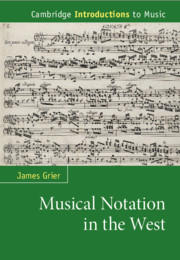Book contents
- Musical Notation in the West
- Musical Notation in the West
- Copyright page
- Dedication
- Contents
- Figures
- Tables
- Musical Examples
- Preface
- Chapter 1 Introduction: Musical Notation as a Symbolic Language
- Chapter 2 Plainsong and the Origins of Musical Notation in the West
- Interlude 1: The Problem with Pitch
- Chapter 3 Polyphony and Rhythmic Notation
- Interlude 2: Rhythm and Metre
- Chapter 4 The Transition to the Modern Era: Instrumental Music and Performing Indications
- Interlude 3: The Score
- Chapter 5 Notational Nuance in the Twentieth Century and the Motives for Notational Innovation
- Coda: The Meaning of Musical Literacy
- Bibliography
- Index
- Cambridge Introductions to Music
Interlude 1: The Problem with Pitch
Published online by Cambridge University Press: 28 January 2021
- Musical Notation in the West
- Musical Notation in the West
- Copyright page
- Dedication
- Contents
- Figures
- Tables
- Musical Examples
- Preface
- Chapter 1 Introduction: Musical Notation as a Symbolic Language
- Chapter 2 Plainsong and the Origins of Musical Notation in the West
- Interlude 1: The Problem with Pitch
- Chapter 3 Polyphony and Rhythmic Notation
- Interlude 2: Rhythm and Metre
- Chapter 4 The Transition to the Modern Era: Instrumental Music and Performing Indications
- Interlude 3: The Score
- Chapter 5 Notational Nuance in the Twentieth Century and the Motives for Notational Innovation
- Coda: The Meaning of Musical Literacy
- Bibliography
- Index
- Cambridge Introductions to Music
Summary
The notations used for chant from the ninth to the early eleventh century give very little information about pitch. As I discuss in Chapter 2, all the early dialects show melodic direction and the littera significatiua e indicates where two consecutive notes lie at a unison. But for the most part, pitch relations remain opaque. The fact that musicians knew three systems for the accurate presentation of pitch in the tenth and eleventh centuries places this situation in high relief: the palaeofrankish and dasian notations mentioned in Chapter 2, to which we can add the alphabetic notation advocated by Hucbald of Saint Amand derived from Boethius and that used in Norman manuscripts.
- Type
- Chapter
- Information
- Musical Notation in the West , pp. 53 - 60Publisher: Cambridge University PressPrint publication year: 2021

